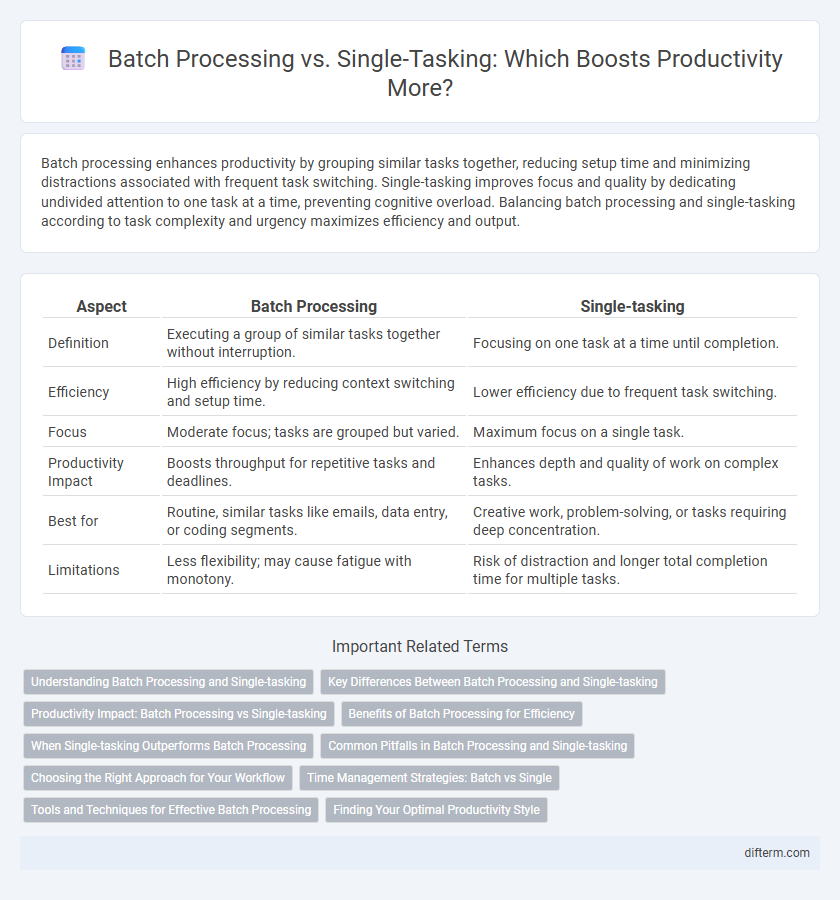Batch processing enhances productivity by grouping similar tasks together, reducing setup time and minimizing distractions associated with frequent task switching. Single-tasking improves focus and quality by dedicating undivided attention to one task at a time, preventing cognitive overload. Balancing batch processing and single-tasking according to task complexity and urgency maximizes efficiency and output.
Table of Comparison
| Aspect | Batch Processing | Single-tasking |
|---|---|---|
| Definition | Executing a group of similar tasks together without interruption. | Focusing on one task at a time until completion. |
| Efficiency | High efficiency by reducing context switching and setup time. | Lower efficiency due to frequent task switching. |
| Focus | Moderate focus; tasks are grouped but varied. | Maximum focus on a single task. |
| Productivity Impact | Boosts throughput for repetitive tasks and deadlines. | Enhances depth and quality of work on complex tasks. |
| Best for | Routine, similar tasks like emails, data entry, or coding segments. | Creative work, problem-solving, or tasks requiring deep concentration. |
| Limitations | Less flexibility; may cause fatigue with monotony. | Risk of distraction and longer total completion time for multiple tasks. |
Understanding Batch Processing and Single-tasking
Batch processing maximizes efficiency by grouping similar tasks together, reducing transition time and cognitive load, which is ideal for repetitive, low-complexity activities. Single-tasking enhances focus and quality by dedicating full attention to one task at a time, crucial for complex, high-demand projects requiring deep concentration. Understanding the strengths of batch processing versus single-tasking helps optimize productivity by aligning task management strategies with the nature of the work.
Key Differences Between Batch Processing and Single-tasking
Batch processing handles multiple tasks simultaneously by grouping them into a single operation, maximizing efficiency in repetitive workflows. Single-tasking involves focusing on one task at a time, enhancing concentration and reducing errors but potentially lowering throughput. Key differences include processing speed, error management, and suitability for complex versus routine tasks.
Productivity Impact: Batch Processing vs Single-tasking
Batch processing significantly enhances productivity by grouping similar tasks to minimize context switching and improve focus, leading to faster completion times and reduced cognitive fatigue. Single-tasking, while promoting deep concentration on individual tasks, can decrease overall output when frequent transitions between different activities are required. Efficient workflow design often favors batch processing for routine or repetitive tasks to maximize throughput and sustain energy levels throughout the workday.
Benefits of Batch Processing for Efficiency
Batch processing enhances productivity by minimizing task-switching, which reduces cognitive load and interruptions, allowing for deeper focus and faster completion of similar tasks. It streamlines workflow by grouping related activities, leading to better time management and increased throughput in both digital and manual operations. Utilizing batch processing can significantly reduce setup times, increase consistency, and improve overall efficiency in professional and personal productivity systems.
When Single-tasking Outperforms Batch Processing
Single-tasking outperforms batch processing in tasks requiring deep focus, creativity, or complex problem-solving where frequent context switching reduces efficiency. When tasks demand high cognitive involvement or real-time decision-making, single-tasking minimizes distractions and improves accuracy. This approach is especially effective in knowledge-intensive work environments or during activities with unpredictable outcomes.
Common Pitfalls in Batch Processing and Single-tasking
Batch processing often leads to decreased focus and increased errors due to cognitive overload when handling multiple similar tasks consecutively, causing productivity bottlenecks. Single-tasking, while promoting deeper concentration, can fall victim to interruptions and poor time allocation, reducing overall efficiency. Both methods require strategic planning to mitigate pitfalls such as diminished accuracy in batch processing and susceptibility to distractions during single-tasking.
Choosing the Right Approach for Your Workflow
Batch processing enhances productivity by grouping similar tasks to minimize transition time and maintain focus, ideal for repetitive or high-volume workloads. Single-tasking optimizes attention and quality by dedicating undivided focus to one task at a time, beneficial for complex or creative projects. Selecting the right approach depends on task nature, deadlines, and cognitive load, ensuring maximum efficiency and output tailored to your specific workflow needs.
Time Management Strategies: Batch vs Single
Batch processing enhances time management by grouping similar tasks to minimize context switching, increasing overall efficiency and reducing cognitive load. Single-tasking allows deeper focus on one task at a time, improving accuracy and quality, especially in complex or creative work. Balancing batch processing for routine activities with single-tasking for high-concentration tasks optimizes productivity and time utilization.
Tools and Techniques for Effective Batch Processing
Batch processing improves productivity by grouping similar tasks to minimize downtime and reduce context switching. Essential tools for effective batch processing include task management software like Trello or Asana, automation platforms such as Zapier, and scripting languages like Python for custom workflows. Techniques like time-blocking, setting clear batch goals, and using templates streamline repetitive tasks, boosting efficiency and focus.
Finding Your Optimal Productivity Style
Batch processing minimizes task-switching by grouping similar tasks together, enhancing focus and reducing cognitive load. Single-tasking emphasizes completing one task at a time with full attention, often leading to higher quality work and less burnout. Identifying your optimal productivity style depends on task complexity, individual focus patterns, and energy levels to balance efficiency and effectiveness.
Batch processing vs Single-tasking Infographic

 difterm.com
difterm.com